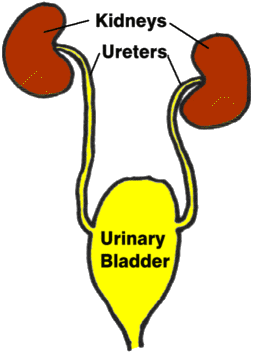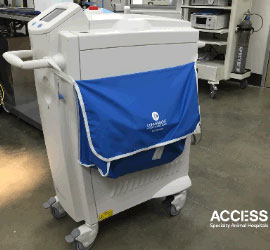Kidneys and Bladder Diagram

Graphic by MarVista Vet
Lithotripsy is a funny word for a minimally invasive alternative to urinary stone removal surgery. "Lith" means stone and "tripsis" means crushing so, in short, lithotripsy refers to breaking stones into fragments small enough to pass. No cutting is involved.
There are two types of lithotripsy: intracorporeal laser lithotripsy and extracorporeal shock wave lithotripsy. The gadget that breaks the stone or stones up is called a lithotriptor (also spelled lithotripter).
Intracorporeal Laser Lithotripsy (Much More Commonly Used)
With this technique, stones can be removed from the lower urinary tract (bladder and urethra). A specific type of laser called a holmium: YAG laser, is used to break up the stone, and endoscopy is needed to get the laser right up to the stone where the patient's tissues are not in the way.
The endoscope that is used in the urinary tract is called a cystoscope and must penetrate the narrow urethral opening of a small animal. Some animals are simply too small for the procedure. Once the cystoscope is in position, the laser uses heat to create water vapor bubbles that rapidly expand and collapse. If these bubbles are in contact with the stone, the crystal structure of the stone is disrupted and the stone breaks apart. The fragments are either allowed to pass, are removed via the cystoscope's collection basket, or are expressed from the bladder manually (voiding urohydropropulsion).
If the stones are in the urethra, disruption of the stone is easiest. If the stones are in the urinary bladder, matters become more complicated. Issues that prevent success include the diameter of the urethra, blood/bleeding obscuring the view of the stone or hampering the laser’s contact with the stone, accidental damage to the bladder from the laser, and prolonged anesthesia time because it is taking so long to fragment the stone(s). Despite these potential problems, studies have reported 83-96% success (i.e. complete stone removal) in female dogs and 68-81% success in male dogs.
Laser lithotriptor machine

Photo by ACCESS Specialty Animal Hospitals
Advantages of Intracorporeal Laser Lithotripsy vs. Surgical Stone Removal
- Patients discharged sooner (often on the same day as the procedure)
- Less invasive. No cutting is required.
- Studies have shown that 100 percent of stones in the urethra can be removed with intracorporeal laser lithotripsy and the median time to complete the procedure was only 36 minutes. This is vastly superior to urethral surgery, which has much more potential for complications.
- Specific equipment is required, and its availability is limited to specialty hospitals.
- Procedure generally takes longer than surgery when stones in the urinary bladder are concerned. The same depth of anesthesia is required as with surgery.
- Generally more expensive than surgery.
- Not an option for male cats or small male dogs.
- If numerous stones are present, lithotripsy is not efficient and surgery should be performed instead. Some facilities recommend against lithotripsy if the pet has more than five stones.
- If the stones are large it may not be time-efficient to use lithotripsy (some facilities recommend against lithotripsy if there is more than one stone of a half inch or more in diameter).
- Because lithotripsy can wash an infection backward and up into the kidneys, a culture of the urine should be performed prior to the procedure. Infection also leads to some urethral swelling, which makes the introduction of the cystoscope more difficult. Any infections should be controlled as best as possible prior to the procedure.
Extracorporeal Shock Wave Lithotripsy
This form of lithotripsy is used to fragment stones in the upper urinary tract: the kidney and ureter. To break up the stone, the patient is anesthetized and a shock wave is focused on the stone. The shock wave must propagate in water so the patient is either partially submerged in a water tank or a “water cushion” is applied to the patient. Commonly over a thousand shocks are delivered to the patient. Certain types of stones are more amenable to this form of fragmentation (calcium oxalate stones are especially amenable in dogs but not in cats, while urate stones, as another example, are not amenable to this form of lithotripsy at all). Stones in the kidney (versus those in the ureter) are more easily fragmented.
Extracorporeal shock wave lithotripsy can be used for stones in the urinary bladder but this is more difficult as the stones tend to move around in the bladder and it becomes difficult to focus the shock waves.
Advantages of Extracorporeal Shock Wave Lithotripsy vs. Surgical Stone Removal
- Cutting into the kidney virtually always reduces kidney function afterward. Kidney function is better preserved with lithotripsy.
- Less invasive to the patient.
- The procedure is successful in 85% of dogs.
Disadvantages
- Specific equipment is required and availability is limited to specialty practices and universities.
- Approximately 10% of cases where lithotripsy was used to fragment a kidney stone ended up with a stone fragment obstructing a ureter. This requires some additional treatment (another lithotripsy, surgery, medical management, etc.)
- Approximately 2 to 3% of cases will develop pancreatitis from the shock waves.
- In order to submit stone fragments for analysis, they must be collected or found after they are passed by the patient.
- It can take several months to pass all the stone fragments.
- 30% of dogs are likely to require a second procedure to complete the fragmentation of kidney stones. For stones in the ureter, 50% of dogs require more than one procedure.
- Reserved for kidney stones 1.5 cm (0.6 inches) in diameter or smaller. Stones larger than this in the kidney will require endoscopic placement of a stent in the urethra so that there will be room to pass the fragments.
If you are interested in this procedure as an alternative to surgery, talk with your veterinarian to find out if there is a specialist facility near you that is equipped for lithotripsy.